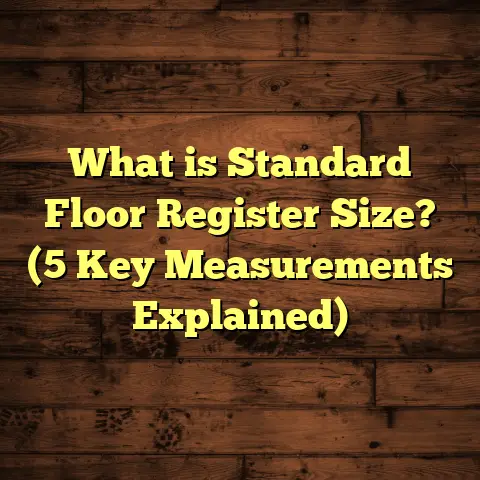What is Hollow to the Floor Measurement? (5 Key Insights Revealed)
Leveraging nostalgia, I can’t help but recall the early days of my flooring career when I first encountered the term “hollow to the floor measurement.” Back then, I thought it was just a minor technical detail—something only contractors needed to worry about. But as I worked on more projects, I realized that this small measurement often made the difference between a flawless installation and a frustrating, costly mess. The way a door fits in relation to the floor can affect everything from the door’s function to your home’s energy efficiency and even its overall aesthetic.
I want to take you through everything I’ve learned about hollow to the floor measurement over the years. This isn’t just some dry technical explanation—I’ll share stories from actual jobs, data-backed insights, and practical advice that can save you time and money on your own flooring project.
What is Hollow to the Floor Measurement?
So, what is hollow to the floor measurement? Simply put, it’s the vertical distance from the bottom edge of a door panel (the part that swings) down to the finished floor surface below it. This space is sometimes called the “door clearance” or “gap under the door.” It’s usually measured in inches or millimeters.
Why does this gap matter? Doors need enough clearance to open and close smoothly without scraping against the floor. If the clearance is too small, the door drags on the floor, causing damage to both door and flooring material. If it’s too large, it can leave an unsightly gap that looks unfinished and lets in drafts, noise, or even insects.
When you replace flooring in your home—upgrading from carpet to hardwood, laminate to tile, or adding thick padding under carpet—the height of your floor changes. That means your existing doors might no longer fit perfectly in their frames because the “hollow to floor” gap is altered.
Measuring and adjusting this gap properly is a key step in any flooring installation or home renovation that involves changing floor height.
How I Learned the Importance Firsthand
I’ll never forget one job early in my career where this misstep caused a lot of headaches. A homeowner replaced their thin vinyl flooring with a beautiful engineered hardwood floor. The new floor was nearly three-quarters of an inch thicker. We installed it perfectly but didn’t check how much space was left under their interior doors.
The next day, every door scraped loudly on the new hardwood. The homeowner was upset, and we had to come back with power tools to trim the bottoms of each door. It was time-consuming and added unexpected costs for everyone involved.
That experience taught me that hollow to floor measurement is not just a technical detail—it’s something every homeowner should understand before starting a flooring project. It’s one of those little things that can make a big difference.
Why Hollow to the Floor Measurement Matters
You might ask: Why fuss over a tiny gap? Why not just trim the doors if needed later? Well, here are some reasons why hollow to floor measurement deserves your attention:
- Smooth Door Operation: Doors need enough clearance to swing freely without scraping or sticking. Too little clearance causes damage; too much clearance can make doors look awkward.
- Energy Efficiency: A proper gap helps maintain airflow and ventilation but prevents unwanted drafts that waste heating or cooling energy.
- Aesthetic Appeal: Uneven gaps or large spaces under doors look unprofessional and detract from your home’s finish.
- Noise Control: Doors that don’t close snugly allow sound to pass more easily between rooms.
- Prevent Flooring Damage: Scraping doors can scratch or dent delicate flooring materials like hardwood or tile.
I’ve handled hundreds of projects where ignoring this measurement caused expensive callbacks and unhappy clients. On the flip side, taking the time to measure carefully upfront often prevents costly mistakes later.
5 Key Insights About Hollow to the Floor Measurement
Let me walk you through five important things I’ve learned about hollow to floor measurement over time:
1. Thickness of Flooring Material Directly Affects Hollow to Floor Clearance
One of the first things you need to know is that different flooring materials add varying thicknesses to your floor height—and that impacts how much space you need under doors.
Here’s a quick rundown of common flooring thicknesses:
| Flooring Type | Typical Thickness (inches) | Notes |
|---|---|---|
| Solid Hardwood | 0.75 | Standard thickness; can vary slightly |
| Engineered Hardwood | 0.25 – 0.75 | Varies by product and wear layer thickness |
| Laminate | 0.28 – 0.47 | Includes underlayment thickness |
| Ceramic Tile | 0.25 | Thin porcelain or ceramic tiles |
| Natural Stone Tile | Up to 0.75 | Marble, granite can be thicker |
| Carpet + Padding | 0.5 – 1.25 | Varies widely depending on padding |
Knowing these numbers helps you estimate how much your floor height will increase after installation.
For example, I once installed thick wool carpet over new padding adding about 1 inch total thickness in a client’s living room. The existing hollow-to-floor clearance was about 3/8 inch—way too small for the new floor height. We had to trim several doors by nearly an inch for them to clear.
If you’re thinking about switching from a thinner floor covering (like vinyl) to something thicker (like hardwood or tile), expect your hollow clearance needs to increase accordingly.
2. Measuring Hollow to Floor Correctly Requires Attention and Tools
Measuring this distance accurately isn’t as simple as holding a tape measure under a door once. Floors are rarely perfectly level, and doors may sag or bow slightly.
Here’s how I measure hollow to floor on my projects:
- Close the door gently without forcing it.
- Measure clearance at three points: left edge, center, right edge.
- Use a feeler gauge for precision if available.
- If you don’t have one, use a metal ruler or tape measure held vertically.
- Record measurements carefully because variance across these points indicates if trimming is needed unevenly.
Sometimes floors slope slightly—either due to settling or poor subfloor preparation—and this can cause one side of a door to drag while the other side clears easily.
Taking multiple measurements helps identify this issue so you can adjust accordingly.
3. Industry Standards Recommend About 3/8 inch Clearance
Most building codes and manufacturers suggest maintaining about 3/8 inch (9.5 mm) clearance between the door bottom and finished floor surface for proper operation.
Why this specific number?
- It allows enough space for most flooring types plus potential expansion.
- It helps maintain airflow under doors—which can be important in rooms without other ventilation.
- Prevents doors from scraping even when floors expand slightly during humid seasons.
On one commercial project I worked on, ignoring this guideline resulted in doors jamming after just a few months due to wood floor expansion from seasonal humidity changes. The fix required removing doors and trimming them down—a costly mistake that could have been avoided.
So, aim for roughly 3/8 inch clearance when planning your flooring project.
4. You Can Adjust Doors After Flooring Installation
If you install new floors without adjusting doors first, don’t worry—you still have options:
- Planing Door Bottoms: Using an electric planer or hand plane to shave off material from the bottom edge.
- Shimming Thresholds: Raising or lowering thresholds during installation.
- Adding Door Sweeps or Weatherstripping: These seal small gaps while maintaining clearance.
- Re-hanging Doors: Sometimes adjusting hinge positions can help.
I often recommend planing as the simplest fix if doors scrape after new floors go down. But beware: some doors have decorative panels or finishes that limit how much material you can safely remove without ruining aesthetics.
5. Planning Ahead Saves Time and Money
The best way to avoid hollow-to-floor headaches is planning ahead:
- Measure existing clearance before removing old floors.
- Know your new flooring thickness including any underlayment or padding.
- Calculate expected new floor height.
- Adjust doors before or during installation rather than after.
On large remodels, coordinating with carpenters or door installers ahead of time helps keep schedules smooth and budgets intact.
I’ve seen projects where flooring crews installed floors first then waited for carpenters to trim dozens of doors afterward—adding days of delay and extra labor charges.
Personal Stories From My Flooring Projects
I want to share some real-world examples from my job sites that show how hollow-to-floor measurement impacts results.
Story #1: The Scraping Bathroom Door
A client was upgrading their bathroom with thick porcelain tile over a mortar bed—adding about 3/8 inch total thickness compared to old vinyl tile. They didn’t think about how this would affect door clearance.
When we installed the tile, their bathroom door scraped loudly every time it opened or closed. It was a frustrating surprise for everyone.
We measured hollow clearance and found only about an eighth of an inch gap left—way too small. We had two options: raise the door frame or trim the door bottom.
We chose planing down the bottom by about 1/4 inch evenly across its width, smoothing edges afterward.
The fix took only a couple of hours but made a huge difference—doors swung smoothly without damage or noise thereafter.
Story #2: Thick Carpet Trimming
Another time, we installed thick wool carpet plus premium padding in a family room where hollow clearance was originally very tight—around 1/4 inch under most interior doors.
After carpet installation, all these doors wouldn’t close properly without dragging heavily on fibers.
We had to remove each door and hand-plane nearly an inch off their bottoms because of combined carpet + padding thickness.
This job taught me to always check carpet pad thickness early in planning—even small changes add up quickly!
Story #3: Commercial Remodel Lessons
I once helped with a commercial office remodel replacing worn-out laminate with natural stone tile averaging 3/4 inch thick including mortar bed.
We documented pre-flooring hollow clearances around 1/2 inch on most interior office doors.
After tile installation, clearances shrank dramatically—some less than 1/8 inch—causing several doors to jam completely in humid weather due to tile expansion jostling frames slightly out of alignment.
Adjusting hinges and planing doors saved costly replacements but delayed project completion by several days.
This reinforced why measuring and accounting for new floor height before finishing installation is critical in any commercial setting too.
Data Insights Backed by Industry Research
To give you more confidence around these insights, here are some relevant statistics:
- According to the National Wood Flooring Association (NWFA), hardwood flooring thickness usually ranges from 0.5 inches (engineered) up to 0.75 inches (solid).
- A survey by HomeAdvisor found that improperly trimmed doors accounted for nearly 15% of callbacks on flooring projects among professional contractors.
- Studies show that seasonal wood floor expansion varies between 0.1% and 0.3% lengthwise depending on humidity levels—enough to cause doors with insufficient clearance to bind or jam.
- Average labor cost for trimming one door bottom professionally runs between $50-$150 depending on location and complexity.
- Flooring waste factors (material leftover during installation) typically range from 5%-10%, meaning extra material thickness introduced by underlayments or subfloor prep may further affect final measurements beyond just flooring thickness itself.
How To Measure Hollow To Floor Yourself: Step-by-Step Guide
If you want to check hollow-to-floor clearance at home before starting your project, here’s how:
- Gather Tools: Tape measure or ruler, flashlight for visibility if needed.
- Close Door Gently: Make sure it’s fully closed but not slammed shut.
- Measure Clearance: Place tape measure vertically from bottom edge of door down to finished floor surface.
- Check Multiple Points: Left edge, center, right edge of door bottom.
- Record Measurements: Write down all numbers; note any differences between points.
- Calculate Needed Clearance: Compare current clearance against recommended 3/8 inch standard plus anticipated new flooring thickness.
- Plan Adjustments: If current clearance is too small compared to new floor height, prepare for trimming doors or other fixes in advance.
Common Questions About Hollow To Floor Measurement
Q: Can I just cut my doors shorter if they drag?
A: Yes, but only if there’s enough material on the bottom edge without ruining design details or finishes. Always measure carefully first.
Q: What if my floor slopes?
A: Take multiple measurements along door width and plan trimming accordingly—sometimes uneven trimming is necessary for smooth operation.
Q: Does hollow clearance affect heating/cooling?
A: Yes! Proper gaps allow airflow which can help HVAC efficiency but gaps too large cause drafts and energy loss.
Q: How thick is typical carpet pad?
A: Usually between 1/4 inch and 3/4 inch depending on quality; add this to carpet thickness when calculating total floor height increase.
Q: Should thresholds be adjusted too?
A: Sometimes yes—especially if changing from low-profile flooring (vinyl) to thicker materials like tile; thresholds can be shimmed or replaced for smooth transition.
Final Thoughts From My Experience
Hollow-to-floor measurement might seem like a small technical detail but trust me—it matters more than most people realize until they face problems firsthand.
Whether you’re installing hardwood in your living room or upgrading carpets in bedrooms, understanding how your new floors affect existing doors saves time, money, and frustration later on.
My advice? Measure carefully before tearing out old floors; factor in all layers including pad/underlayment; plan for at least 3/8 inch clearance; and adjust doors thoughtfully during installation rather than rushing fixes afterward.
If you keep these points in mind based on my years of hands-on experience, your floors will look great—and your doors will swing smoothly for years to come.
Have specific questions about your project? Just ask—I’m happy to help you avoid these common pitfalls!





